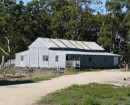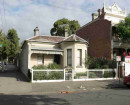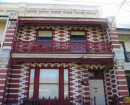GLOBE THEATRE
17-19 WILLIS STREET WINCHELSEA, SURF COAST SHIRE
-
Add to tour
You must log in to do that.
-
Share
-
Shortlist place
You must log in to do that.
- Download report


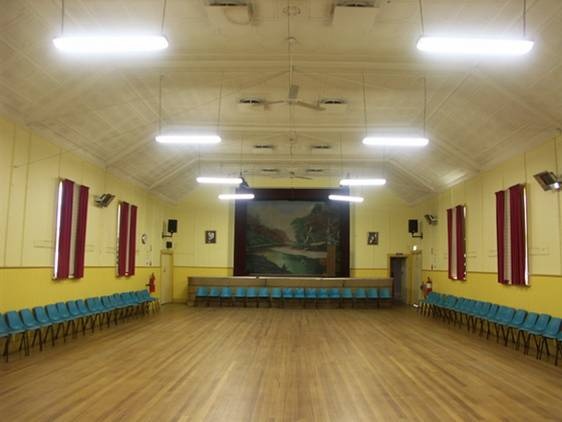
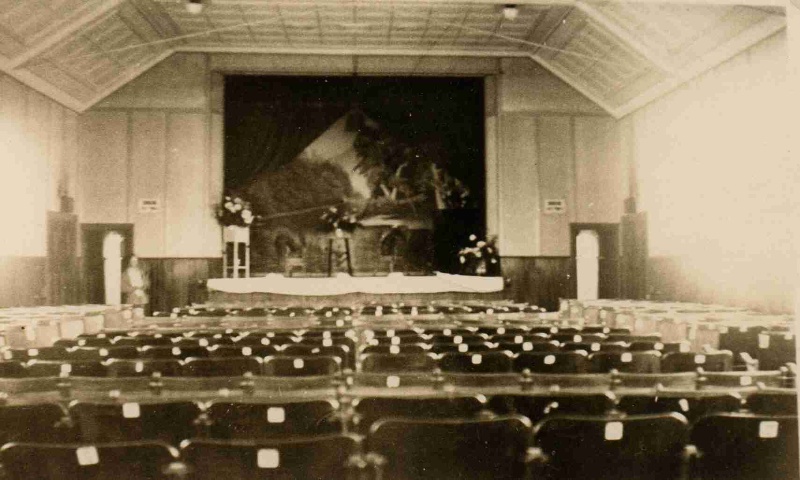

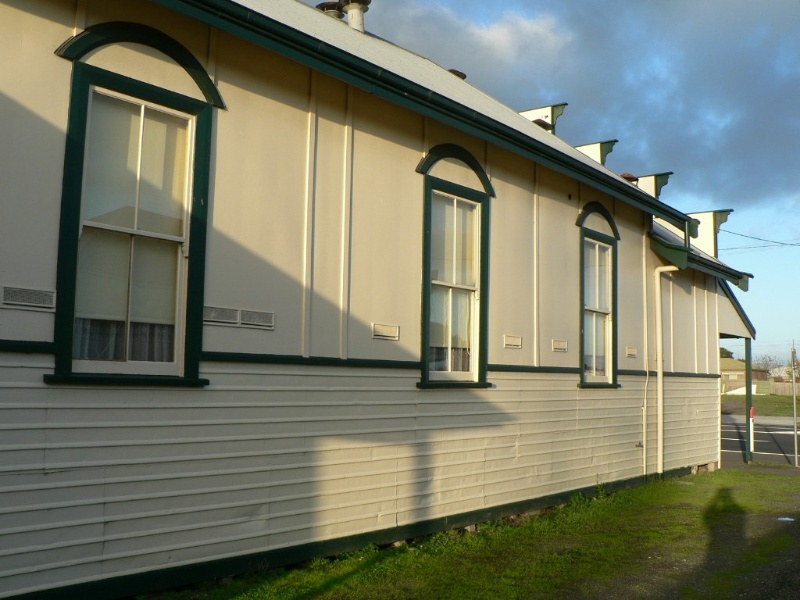
Statement of Significance
What is significant?
The Globe Theatre was built in Winchelsea in 1926-27 as a picture theatre and concert hall. Constructed by the Lawrence family, it provided a venue for the local talent, Marjorie Lawrence, to perform. Lawrence, who became an internationally acclaimed soprano, gave her farewell concert in the building in 1928, prior to studying in Paris, and gave her first return concert there in 1939. The theatre was also used for movie screenings, weddings, dances and horticultural shows. In 1946 the theatre was acquired by the Winchelsea Shire Council and since 1990 has been managed by the local Lions Club.
The simple, hall-like building has a main broad gable roof and a smaller gable to the front, both of which terminate in eaves along the sides of the building. At the front, a bold, bracketed, stepped parapet conceals the building behind. The original skillion verandah across the front facade was replaced by one of similar form in 1992. Paired ventilation stacks dominate the ridge line of the main roof. The original portions of the building are clad with galvanised iron sheeting to dado level, folded to reflect strapped horizontal boards. The upper walls are clad with strapped cement sheets. Double hung, paned windows with segmental arched pediments above, line the sides of the hall, and paned windows and ticket openings flank the central front entrance.
The interior of the main hall has a coved, decorative pressed metal ceiling, with pressed metal ceiling roses and ventilation openings. An original landscape scenery back drop remains in place at the rear of the stage. Interior walls of the foyer and the hall have timber dados, strapped cement sheet wall cladding and pressed metal ceilings.
The original dressing rooms at the rear of the building have been replaced by a brick addition.
How is it significant?
The Globe Theatre, Winchelsea is of architectural and historical significance to the State of Victoria.
Why is it significant?
The Globe Theatre, Winchelsea is of historical significance for its association with Marjorie Lawrence, who became the leading dramatic soprano for the Paris Opera Company and also triumphed in New York, performing with the Metropolitan Opera.
The Globe Theatre, Winchelsea is of architectural significance as a small, intact example of a theatre built in a Victorian country town. The building retains much of its early form and original decoration, including a rare surviving early scenery backdrop.
The Globe Theatre, Winchelsea is of scientific (technical) significance for its use of galvanised iron folded sheeting as a form of cladding. This form of cladding would appear to be highly unusual.
-
-
GLOBE THEATRE - History
General Background
On 19 November 1834 the arrival of the Henty brothers in Portland Bay marked the beginning of European settlement in Victoria, which was then known as the Port Phillip District. In the following year John Batman concluded his treaty (on behalf of the Van Dieman's Land-based Port Phillip Association) with the Aboriginal inhabitants for the ownership of about a million acres of land on the west of Port Phillip Bay. While the Colonial Office subsequently denounced the treaty, Batman's reports across Bass Strait excited interest of many prospective pastoralists. This was reinforced in 1836 by Major Thomas Mitchell during his expedition through Victoria, which he called 'Australia Felix'.By 1837, settlement on the Barwon River within the former Shire of Winchelsea had been well established. Those in possession of significant landholdings included: The Derwent Company, Thomas and S.L. Learmonth, John Highest and William Harding, Hugh Murray, G.T. Lloyd, G.A. Anstey, A. Morris and W. Carter, the Austin brothers - Thomas, Josiah and Solomon, Henry Hopkins, C. Armytage and Sons, and Thomas Ricketts.
As a result of the European settlement of the land came the establishment of overland trade routes. The transportation of provisions between the fledgling towns, centres and pastoral stations in Victoria witnessed the development of country stores. The rapid progress of Geelong and the Western District at this time brought about the beginnings of a settlement on the Barwon River now known as Winchelsea, on the route between Geelong and Colac.
It was in December 1842 when Charles Beal, accompanied by P.N. Trebeck, founded the township of Winchelsea which they originally called "The Barwon". It was situated near a natural ford in the Barwon River. There, they built the Barwon Hotel and the first general store.
The township of Winchelsea was first surveyed and laid out by A.J. Skene on 4 December 1850. In 1851, Governor Latrobe, then Superintendent, submitted the name of "Winchelsea" for approval. It was named after the English port of Winchelsea. The township was laid out on the western bank of the River, with some "suburban" residential allotments on the opposite bank. Settlement soon developed, particularly after the construction of the timber bridge over the Barwon in c.1851 when the volume of bullock drays and other traffic increased. In 1867, this bridge was replaced by the existing bluestone bridge.
From the mid 19th century, Winchelsea became an early centre for commerce, education, postal services and social activities; the home of station hands, shearers and some tradesmen who worked for the numerous graziers and farmers that constituted the outlying population; the retirement location for a number of people from the land; and the place of residence of the population providing the support infrastructure - including bankers, store keepers, hotel keepers, teachers and employees of the Winchelsea Shire.
The late 19th and early 20th centuries witnessed further developments in the town. St. John the Baptist Romann Catholic Church was built in 1893, while the original public library behind the Barwon Hotel was replaced with a new building on the triangular block on the Geelong side of the bridge in 1894. In 1908, the Winchelsea Shire Hall was replaced with a commodious new building. In 1914, the Winchelsea Water Works Trust was constituted. After the Great War a substantial grandstand was erected at the Eastern Reserve in 1923 as a functional memorial to the people of Winchelsea and district who served in the armed services.
By the mid 20th century, the steady progress in the evolution and development of Winchelsea had slowed. This resulted from the opening the Great Ocean Road (initially between Torquay and Eastern View from 1922), drawing the passing tourist trade away from Winchelsea. The rapid decline of the town as a stopping place also resulted from technological advances in vehicular transport, with the ability of motor cars and trucks to travel great distances without the need for roadside stops. A small increase in the population came in the 1950s, when Housing Commission homes were built for employees of the nearby coal mine.
History of the Globe Theatre
Beginnings
The Globe Theatre was built in 1926-27 by the father (William) and brothers of Marjorie Lawrence, a local who was to become a famous international singer. Along with her siblings: Edwin Robert, Lindsay William, Percy James and Eileen Beatrice, Marjorie was recorded as the owner of the Globe Theatre in an insurance policy dated 9 May 1927.The theatre was insured for £2000, with furniture and fittings insured for £200. Established as a picture theatre, the insured items also included an "Aristone" player piano and a "Simplex" Motion Picture machine for showing movies. It was from 1910 when Broadwood's were among the first British piano makers to make player pianos. Simplex motion picture machines had also grown into international popularity after their full production in 1910 and by 1913 they had been installed in many well-known theatres in the United Kingdom, including the London Hippodrome; Blue Hall, Hammersmith; B.B. Pictures, Glasgow; Royal Bioscope, Liverpool; Victoria Hall, York and Lizars, Edinburgh. The Globe Theatre insurance policy for 1927 also allowed the use of the Simplex motion picture machine to be driven by electric motor. However, the policy did not allow for movable or specially lit scenery or for the carrying on of vaudeville entertainments. A year later in 1928, a theatre licence had not been granted by the Theatre Commission as the stage did not comply with its Building Regulations, although 'concerts may be held but no movable scenery, hangings or changes of costume' were allowed.
The Globe Theatre & Marjorie Lawrence
No details have been ascertained which explain the reasons for the Lawrence family's establishment of the Globe Theatre. However, it is known that Marjorie Lawrence's father, William, initially opposed her removal in 1926 to Melbourne with her brother, Cyril (probably formally named Percy James), in search of work as a singer. Arguably, the building of the Globe Theatre might have been an attempt by William Lawrence to keep his daughter 'at home'.Born on 17 February 1907 at Deans Marsh to William and Elizabeth Lawrence, her very earliest exposure to music may have come from her mother who was the local Church organist (although tragedy struck the family when Elizabeth died in 1909). Marjorie was educated at local schools and from the age of 10 she was a regular soloist. It was from the gramophone records of Nellie Melba and Clara Butt (held by the local Anglican parson) that refined Marjorie's musical tastes. At the age of 14, William Lawrence relocated the family to a property near Winchelsea.
In Melbourne in 1926, Marjorie paid Ivor Boustead to train her voice and in the same year she entered a musical competition at Colac where she received one equal first and two second prizes. Forced home to Winchelsea by impecuniousness, Marjorie had little success at the Ballarat South Street competitions, but in 1928 she won the Sun Aria contest in Geelong.
In 1928, William Lawrence decided to send his daughter to Paris to study under Madam Cecile Ghilly for three years. Marjorie gave a farewell performance at the Globe Theatre on 21 September 1928, amid a large audience. In Paris from December 1928, she made her debut as Elisabeth in Tannhauser at Monte Carlo in 1932, a performance acclaimed by critics as comparable with those of Chaliapin and Caruso. From 1933, Marjorie held a number of dramatic leads for the Paris Opera over four seasons, becoming the company's leading dramatic soprano. In 1935, she triumphed in New York and had six seasons with the Metropolitan Opera at home and on tour (her brother Cyril, acting as her manager). According to H.M. Griffin in the Australian Dictionary of Biography, 'her physical grace enchanted audiences.' Visiting Australia in 1939, 1944, 1951, 1966 and 1976, Marjorie 'kept a promise in 1939 to perform first at Winchelsea.' Details of her triumphant homecoming are outlined by Cr W.L. Koenig in The History of the Winchelsea Shire:
"A reception was given to Miss Lawrence on June 16th, by, and at the expense of the Councillors and Officers of the Shire. An escort of men and women on horseback organised by the ranger, Mr E Caldow, met her at the outskirts of the town and led her car across the Barwon Bridge, where they lined up on either side of the highway and formed a guard of honour from the bridge to the Shire Hall gates. Another guard of honour, consisting of school children, was drawn up on either side of the path leading from the gate to the Hall. She was met at the entrance to the hall grounds by the Shire Secretary, Mr Westhorpe, and introduced to the Shire President, Cr Dorman, Mrs Dorman and the Councillors and their wives, while the children, who were then brought around to the hall door, sang Home Sweet Home. A bouquet was presented on behalf of the children before Miss Lawrence and the official party entered the hall, where the President's wife handed her another floral tribute. The President then presented a copy of the History of the Shire, compiled by Cr Koenig, bearing a suitable inscription, and the signatures of the Councillors and Officers. Cr Allan McDonald, MLA, the member for the district, gave the official address of welcome on behalf of the Municipality, and Mrs J S Mathison welcomed her on behalf of the women. Miss Lawrence, responding with considerable emotion, said: "I shall never forget this wonderful day. Of all my triumphs this is the one I shall remember, but of which I can say nothing." The proceedings were broadcast by means of amplifiers to a large gathering in the Shire Hall grounds which were decorated with an array of bunting hired from the Geelong City Council. The reception ended with afternoon tea, served to 180 guests, consisting of Miss Lawrence, her relatives, school mates, and close friends.
That evening the citizens tendered a welcome to the prima donna in the Globe Theatre, where a dance-programme, interspersed with music, commenced at eight o'clock. Miss Lawrence and her party arrived half an hour later, and the local orchestra led the assembly in singing, "For She's a Jolly Good Fellow," while the guests were escorted to their seats. Mr McDonald, MLA, acting for the citizens, then presented Miss Lawrence with a diamond brooch as a memoir of her home coming. The expenses of this citizens' welcome were defrayed by a small charge at the door. Four hundred people attended the function, and a balance of £5/11/1 was donated to the Marjorie Lawrence Baby Health Centre. On the following evening, Saturday 17th June, 1939, Marjorie Lawrence assisted by Alfredo Luizzi, baritone, and Felix Wolfes, accompanist, made her first concert appearance on her home coming tour in the Globe Theatre at Winchelsea. The limited seating accommodation made it impossible to accept bookings from persons residing beyond the Winchelsea Shire boundary. Applications were received from as far away as Launceston, but with the exception of seats reserved for press representatives, some of whom came from Sydney, the 480 seats available were occupied by residents of the Shire."
Marjorie Lawrence's return to Winchelsea in 1944 also heralded another performance at the Globe Theatre, as outlined by Koenig: "That evening [Saturday, 29th July, 1944], Miss Lawrence, the now world-famous operatic star, sang again to a crowded and enthusiastic audience of her "Ain Folk" in the old Globe Theatre, which her father had built at Winchelsea in 1926. Much credit is due to the Shire Secretary, Mr W W Westhorpe, for his successful organisation of both Miss Lawrence's visits to Winchelsea."
Between her homecomings, Marjorie suffered an attack of poliomyelitis in 1941, leaving her paralyzed in both legs. She married the osteopath and Christian Scientist, Thomas King on 29 March 1941 at City Hall, New York. Making her first public reappearance in 1942, Lawrence was later to perform at many notable places such as Buckingham Palace and the White House, as well as entertaining troops in Australia (1944), occupied Europe (1945) and Vietnam (1966). In 1946, Marjorie was the recipient of the French cross of the Legion d'honneur and in 1976 was appointed a Commander of the British Empire (C.B.E.). A movie entitled "Interrupted Melody" was released in 1955, which told her life story. She died on 13 January 1979 at St. Vincent's Hospital, Little Rock, Arkansas, U.S.A.
Other Associations with the Globe Theatre
Movie Pictures
Popular throughout the 20th century at the Globe Theatre was the showing of movie pictures. In 1946, the Public Health Department stipulated that a certified Cinematographer had to be used for the operation of the movie projector. Two years later in 1948, talking movies were shown there, the popularity of the theatre being revealed in the Globe's Ledger Book for 1951-52 which included a long list of well-known film studios (including Warner Brothers, Universal, Fox, Paramount and Metro) as suppliers of movies.Social Events
The Globe Theatre has played host to a number of social events since its erection in 1926-27. For many years it was the location of the Winchelsea Horticultural Society's Annual Show. Other events have included weddings (including the wedding of Lindsay Lawrence and Evonne Batson in 1931), balls and other dances, concerts, school speech nights, Art and Craft shows, meetings, and as a Red Cross emergency station (as in 1983 when the Red Cross used the hall for 5 successive days and nights during and after the Ash Wednesday bushfires).Later Owners & Managers
While Marjorie Lawrence and her siblings were identified in the insurance policy in 1927 as owners of the Globe Theatre, it is of interest that the Winchelsea Shire Rate Books list a smaller number of Lawrence family members as the custodians of the building. In 1926-27, the owners were listed as Lindsay W., E.R. (Edwin R.) and Eileen B.Lawrence. It appears that Marjorie and her brother Percy were not named given their absence from Winchelsea. Marjorie's brothers and sister continued to own the Globe Theatre until 1946. At that time, a newspaper reported that efforts were being made to raise funds for the purchase of the theatre and that 'an encouraging response' had been given by the local community. Subsequently, the Globe Theatre was acquired by the Winchelsea Shire Council in 1946 which established five trustees (known as the Globe Theatre Trustees) to manage the building. In September 1990, the management of the theatre was officially handed over to the Winchelsea Lions Club, in an attempt by the Shire to have the building used more regularly. In return for the use of the theatre as club rooms, the Lions Club were to maintain and improve the building using income raised from theatre usage, voluntary labour and council contributions.Building Developments
The site of the Globe Theatre at 17-19 Willis Street initially formed part of allotment 1, Section 3 in the Winchelsea Town Plan, the first owner being A.A. Austin from 12 December 1852. By 1925-26, the land consisted of 3 roods and 8 perches and included a garage building owned by John Galvin Downes, car proprietor.In 1926, construction commenced on the Globe Theatre. A sketch plan in the Public Building files at the Public Records Office Victoria shows a hall measuring 133 feet by 64 feet, a platform (12 feet by 64 feet), two rear dressing rooms (16 feet 4 inches by 12 feet) and a central front entrance foyer (measuring 9 feet 6 inches by 8 feet) and two flanking sales booths (11 feet by 12 feet 2 inches). The insurance policy of 1927 described the building as 'having walls of iron and durabestos, partitions of wood and durabestos, roof of iron', and that it was 'detached not less than 30 ft. from any other buildings, situate MAIN STREET, WINCHELSEA.' An early photograph of the building in 1928 shows that it was characterised by a broad gable roof form adorned by paired ventilation stacks along the ridge line, together with a smaller gable at the front dominated by a distinctive stepped parapet. A skillion verandah surmounted by a minor gable above the entrance projected at the front and was supported by timber posts with small timber brackets. An interior photograph of 1928 shows that the hall was designed with a coved pressed metal ceiling, the walls having stained timber dados with strapped cement sheet above. The stage featured a picturesque landscape scene.
Since its construction, the Globe Theatre has experienced few changes. The changes that have been recorded include the following:
*1949: enlargement of door opening between the rear dressing rooms.
*1949-50: alterations and extensions to the bio box cabin.
*1967: demolition of rear dressing rooms and construction of a new gabled supper room and toilets. *1973: hall floor replaced (in timber).
*1992: replacement of front verandah, after the original was substantial demolished by a wayward passing truck in December 1991.
GLOBE THEATRE - Plaque Citation
This picture theatre and concert hall was constructed in 1926-27 by the Lawrence family. It provided a venue for their daughter, the local talent and internationally acclaimed soprano, Marjorie Lawrence, to perform.
GLOBE THEATRE - Assessment Against Criteria
ASSESSMENT AGAINST CRITERIA
a. Importance to the course, or pattern, of Victoria's cultural history
The Globe Theatre is illustrative of one of the most popular forms of entertainment in the twentieth century, the cinema.
b. Possession of uncommon, rare or endangered aspects of Victoria's cultural history.
c. Potential to yield information that will contribute to an understanding of Victoria's cultural history.
d. Importance in demonstrating the principal characteristics of a class of cultural places or environments.
The Globe Theatre is a representative example of a small, intact Victorian country theatre, which retains much of its original interior detail, including a rare surviving early scenery backdrop. The use of galvanised iron sheeting, folded to resemble horizontal sheeting, is highly unusual.
e. Importance in exhibiting particular aesthetic characteristics.
f. Importance in demonstrating a high degree of creative or technical achievement at a particular period.
g. Strong or special association with a particular community or cultural group for social, cultural or spiritual reasons. This includes the significance of a place to Indigenous peoples as part of their continuing and developing cultural traditions.
h. Special association with the life or works of a person, or group of persons, of importance in Victoria's history.
The Globe Theatre has close associations with international soprano Marjorie Lawrence, for whom it was built.
GLOBE THEATRE - Permit Exemptions
General Exemptions:General exemptions apply to all places and objects included in the Victorian Heritage Register (VHR). General exemptions have been designed to allow everyday activities, maintenance and changes to your property, which don’t harm its cultural heritage significance, to proceed without the need to obtain approvals under the Heritage Act 2017.Places of worship: In some circumstances, you can alter a place of worship to accommodate religious practices without a permit, but you must notify the Executive Director of Heritage Victoria before you start the works or activities at least 20 business days before the works or activities are to commence.Subdivision/consolidation: Permit exemptions exist for some subdivisions and consolidations. If the subdivision or consolidation is in accordance with a planning permit granted under Part 4 of the Planning and Environment Act 1987 and the application for the planning permit was referred to the Executive Director of Heritage Victoria as a determining referral authority, a permit is not required.Specific exemptions may also apply to your registered place or object. If applicable, these are listed below. Specific exemptions are tailored to the conservation and management needs of an individual registered place or object and set out works and activities that are exempt from the requirements of a permit. Specific exemptions prevail if they conflict with general exemptions. Find out more about heritage permit exemptions here.Specific Exemptions:General Conditions: 1. All exempted alterations are to be planned and carried out in a manner which prevents damage to the fabric of the registered place or object. General Conditions: 2. Should it become apparent during further inspection or the carrying out of works that original or previously hidden or inaccessible details of the place or object are revealed which relate to the significance of the place or object, then the exemption covering such works shall cease and Heritage Victoria shall be notified as soon as possible. Note: All archaeological places have the potential to contain significant sub-surface artefacts and other remains. In most cases it will be necessary to obtain approval from the Executive Director, Heritage Victoria before the undertaking any works that have a significant sub-surface component. General Conditions: 3. If there is a conservation policy and plan endorsed by the Executive Director, all works shall be in accordance with it. Note: The existence of a Conservation Management Plan or a Heritage Action Plan endorsed by the Executive Director, Heritage Victoria provides guidance for the management of the heritage values associated with the site. It may not be necessary to obtain a heritage permit for certain works specified in the management plan. General Conditions: 4. Nothing in this determination prevents the Executive Director from amending or rescinding all or any of the permit exemptions. General Conditions: 5. Nothing in this determination exempts owners or their agents from the responsibility to seek relevant planning or building permits from the responsible authorities where applicable. Minor Works : Note: Any Minor Works that in the opinion of the Executive Director will not adversely affect the heritage significance of the place may be exempt from the permit requirements of the Heritage Act. A person proposing to undertake minor works may submit a proposal to the Executive Director. If the Executive Director is satisfied that the proposed works will not adversely affect the heritage values of the site, the applicant may be exempted from the requirement to obtain a heritage permit. If an applicant is uncertain whether a heritage permit is required, it is recommended that the permits co-ordinator be contacted.Exterior:
Minor repairs and maintenance.
Removal of extraneous items such as air conditioners, pipe work, ducting, wiring, antennae, aerials etc, and making good.
Installation and repairing of damp proofing by either injection method or grout pocket method.
Installation or removal of external fixtures and fittings such as, hot water services and taps.
Interior:
Installation, removal or replacement of projection and sound equipment (excluding early or significant equipment), providing they do not adversely impact on significant elements, or involve structural alterations.
Painting of previously painted walls and ceilings in appropriate heritage colour schemes, provided that preparation or painting does not remove evidence of any original paint or other decorative scheme.
Installation, removal or replacement of carpets and/or flexible floor coverings.
Installation, removal or replacement of screens or curtains, including cinema screens and curtains (and associated structure), curtain tracks, rods and blinds, other than where structural alterations are required.
Installation, removal or replacement of hooks, nails and other devices for the hanging of mirrors, paintings and other wall mounted art works.
Removal or replacement of non-original door and window furniture including, hinges, locks, knobsets and sash lifts.
Installation, removal or replacement of ducted, hydronic or concealed radiant type heating provided that the installation does not damage existing skirtings and architraves and that the central plant is concealed.
Installation, removal or replacement of electric clocks, public address systems, detectors, alarms, emergency lights, exit signs, luminaires and the like on plaster surfaces.
Installation, removal or replacement of bulk insulation in the roof space.
Installation of plant within the roof space, providing that it does not impact on the external appearance of the building or involve structural changes.
Installation of new fire hydrant services including sprinklers, fire doors and elements affixed to plaster surfaces.
Installation, removal or replacement of electrical wiring.
Installation, removal or replacement of fixed seating, other than early or original seating.Brick Addition at Rear:
Any interior works to the brick addition at the rear of the building.GLOBE THEATRE - Permit Exemption Policy
The purpose of the Permit Policy is to assist when considering or making decisions regarding works to the place. It is recommended that any proposed works be discussed with an officer of Heritage Victoria prior to them being undertaken or a permit is applied for. Discussing any proposed works will assist in answering any questions the owner may have and aid any decisions regarding works to the place. It is recommended that a Conservation Management Plan is undertaken to assist with the future management of the cultural significance of the place.
The significance of the Globe Theatre, Winchelsea is due to its intact and representative character as a small Victorian country theatre, and to its associations with the major form of mass entertainment in the early 20th century. Important elements include the building's front and side facades, particularly the folded galvanised iron cladding, and interior features including the pressed metal ceiling and ceiling roses, the ventilation openings and the original landscape scenery back drop at the rear of the stage in the hall, and the timber dados and strapped cement sheet wall cladding of the foyer and hall. The alteration or removal of these elements would require a permit.
Permit exemptions will only be granted for the landscape scenery backdrop if a Conservation Management Policy [CMP] has been developed for the object, and this CMP has been endorsed by the Executive Director. Once an endorsed CMP has been implemented, the object type may be subject to a review to enable a class of standard, or specific, permit exemptions to be granted.
Later modifications to the building include a gabled brick addition at the rear of the building, and the replacement of the front verandah in 1991. Reinstatement of the latter, if it is undertaken, should be based on early images of the building.
The purpose of the permit exemptions is to allow works that do not impact on the significance of the place to occur without the need for a permit.
-
-
-
-
-
WINCHELSEA BRIDGE
 Victorian Heritage Register H1456
Victorian Heritage Register H1456 -
MEMORIAL GRANDSTAND AND GATES
 Victorian Heritage Register H1525
Victorian Heritage Register H1525 -
FORMER WINCHELSEA RAILWAY STATION
 Victorian Heritage Inventory
Victorian Heritage Inventory
-
'YARROLA'
 Boroondara City
Boroondara City -
1 Bradford Avenue
 Boroondara City
Boroondara City
-
-





